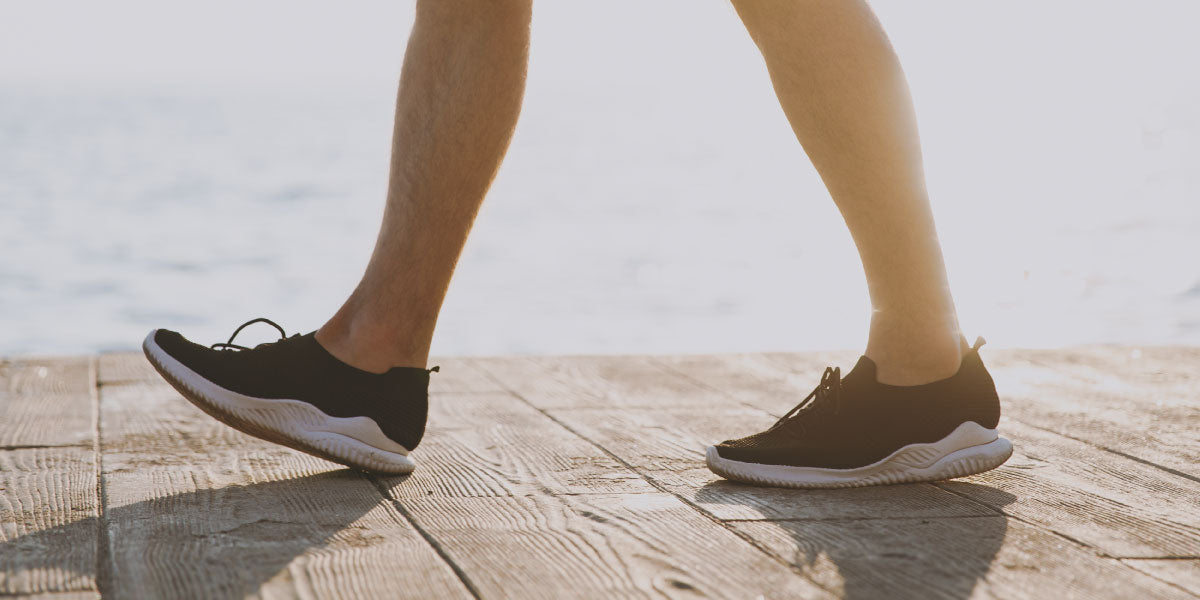The ideal mindset to live life is usually summarized in a popular quote that reads - There is no elevator to success, you have to take the stairs. While this refers to the grind and hard work without which no momentous task can be accomplished, when understood in the literal sense, it also hints at the remarkable effects of walking for overall wellness.
An incredible way to maintain health, you’d be surprised to know walking also happens to be one of the most studied types of exercise. Following is a detailed elucidation about why it’s important to walk your way to fitness, for it is a safe and effective practice for all age groups.
Body’s response to walking and associated benefits:
As we swing our arms and move our legs while walking, there are two main actions (amongst many others) that take place - bending (flexion) and extension of our bones and muscles [1]. Here’s a brief outline to better understand how the revolutionary adaptations taking place within that (while walking) contribute to the wide-ranging benefits-
- Increases muscle mass: Muscles are usually the most talked about in exercise-related discussions, because they undergo a significant transformation when put to work. During walking, legs, abdominal and even arm muscles are exposed to stress. The force causes small tears in the muscles which the body quickly works on repairing, thereby increasing the mass while toning them [2]. A high muscle mass is advantageous as muscle is an extremely active tissue, so it uses more energy and helps burn calories and lose weight [3].

- Improved bone health: Our bones need physical stimulation to strengthen and this too is achieved by exercise. Brisk walking promotes bone health by increasing bone mass and density [7, 8].
- Reduces insulin resistance: This increased muscle mass also has an outcome on glucose uptake by cells. Glucose is a carbohydrate derived from the food we eat and is the chief source of energy in our body, acting as a fuel to carry out all tasks. After consuming a meal, as the body breaks down carbs, the blood glucose levels rise. That’s when a hormone called insulin is released that signals the cells to take up glucose from the bloodstream so it can be used for energy. However, there’s a condition called insulin resistance where people are unable to absorb glucose from the blood. This is dangerous as the cells can starve in such a case due to the lack of energy. But the good news is, the increased muscle mass linked to walking reverses this condition and improves insulin sensitivity [4, 5, 6].

- Influences mental health: Our body releases hormones called endorphins during exercise. Endorphins are ‘feel-good’ chemicals that interact with the brain receptors and reduce the perception of pain, trigger a positive feeling and provide an energy boost [9]. Taking a stroll amidst nature is especially beneficial as it enhances your mood and creativity and can even be a form of meditation. Studies also positively show nature walk reduces ruminating over negative experiences or thoughts, which can lower the risk of depression [10, 11].

- Contributes to a happy heart: As a source of one of the easiest forms of physical activities, walking enhances heart rate, strengthens your heart, and increases blood circulation, transporting more oxygen and nutrients to organs [12]. Walking for just 30 minutes per day has the potential to curtail your risk of heart disease by 19% [13].
Positive effects of walking at different stages of life
Now that we’ve discussed some of the amazing advantages of walking, let’s understand how it can positively affect a certain age group.
1. Children and adolescents (3-17 years)
While global obesity is on the rise in most sections of the population, in just three decades, it has specifically increased by 10-fold in school-going children and adolescents. In India alone, the prevalence of obesity in this age group is between 3.6-11.7%. By 2025, 17 million Indian children are predicted to be obese [14].

This steep increase in number can majorly be attributed to the change in dietary and behavioural factors - increased calorie consumption and reduced physical activity [14]. It thus becomes crucial to encourage this age group to engage in walking. Moreover, it has the added advantage of improving cognitive function in children and reduces the risk of cognitive impairment (characterized by trouble in remembering, concentrating and learning new things) [15, 16].
Data collected from WHO also suggested similar concerns, as over 80% of school-going adolescents worldwide did not meet current recommendations of minimum one hour of physical activity per day [17]. The alarming numbers entail the importance of including brisk walking in everyday routine to reach the target levels of exercise.

Along with the earlier listed benefits, walking is especially constructive for adolescent school girls as it helps minimize polycystic ovary syndrome (PCOS). PCOS is a health disorder caused by hormonal imbalance in women of childbearing age. It can lead to infertility and cysts in the ovaries. Walking, by supporting weight loss, helps reduce excess testosterone levels and improves our response to insulin (which otherwise are a cause of concern for women with PCOS). This can, in turn, also improve the frequency of menstrual cycles and ovulation as well as help with symptoms of anxiety [11, 18, 19].
2. Younger adults (18-25 years)
As the adolescents step into University, learn self-sufficiency and get independent, the transformation comes with its fair share of challenges. While this age bracket consists of increased responsibilities and evolving mindsets, a common sight amongst them is also obesity, low physical activity and time constraints to exercise [20, 21].

This is highlighted in a study where a broad section of both men and women in India above the age of 20 years were found to be inactive. Among the same age group, the number of people who engaged in recreational physical activity was far less (fewer than 10%) [22]. When it comes to worldwide statistics, global data from 168 countries, including India, depicts that 27·5% of adults are “insufficiently physically active” and do not meet the WHO norms, with women being less active than men [23].
But workload from studies or stress from the first job is never a good enough reason to skip walking. In fact, regular walks can improve the physical activity and heart health of youth [24]. It also correlates to improved levels of blood pressure and lipid profile (the amount of cholesterol and fats in the blood) [13].
Walking is additionally essential to weight loss and emotional health. A 9-month walking program in overweight young adults showed fat mass reduction, increase of physical working capacity, improvement of emotional stability and self-confidence [25].
3. Adults (26-64 years)
As the younger cherubic days transition into adulthood, our metabolism tends to slow down. Being less active and losing muscle mass contributes to this process, but contrarily, walking helps maintain our metabolism by ensuring improvement of physical function and muscular strength [2, 26].

Remember how the younger generation is constantly advised to take special care of their health as the consequences of ignorance will be faced later on? That’s because, in our thirties, the risk factors that increase the chances of lifestyle diseases (medical conditions linked to how a person spends his life) begin to occur [27]. But walking exercises can significantly lower insulin resistance as well as abdominal obesity in obese women. It is especially essential to keep the latter in check as the fat around our organs can have serious health consequences including heart diseases [4, 28]. Walking more than 2 hours per week is known to reduce the risk of premature death as well [29].
Apart from this, the third decade of our life is also the period when bone mass starts decreasing. So it becomes all the more necessary to ensure overall bone health, which can be achieved through brisk walking [30].
The importance of engaging in physical activity is a frequently discussed topic amongst millennials, but if committing to the gym every day seems like a strenuous task, you may want to befriend the art of walking. Not only is it convenient, it’s also easier than other forms of exercise like running since it creates less stress on joints and reduces pain - making it especially beneficial for people with osteoarthritis (degenerative joint disease) and osteoporosis (a condition of weak bones that are susceptible to fractures) [7, 8, 31].
With the passing of years, heartburns and other reflux symptoms tend to become common complaints. But since walking helps speed up the time it takes for food to move from the stomach into the small intestine, it’s a suitable option to prevent these conditions [32].
Walking during pregnancy:

Like in all other stages of life, walking holds eminence in pregnancy too. It improves mood throughout pregnancy and after birth [33]. Walking at a brisk pace helps in decreasing the risk for several complications like-
- gestational diabetes mellitus (GDM): diabetes associated with pregnancy because placenta prevents the body to make use of insulin [34, 35]
- preeclampsia: a condition characterized by high blood pressure and swelling [36]
- excessive gestational weight gain [37]
It can also help in birthing healthy babies as walking in early to late pregnancy is associated with a 14%–39% decreased risk of macrosomia (a new born with an excessive birth weight) and potentially with a decreased risk of low birth weight. However, since this is a vulnerable group, it is advised to consult your gynaecologist before engaging in physical activity [36].
While there is no shortcut to good health and one must follow an overall nourishing lifestyle, given its virtues, Dr Thomas Frieden, former Director of the Centres for Disease Control and Prevention, called walking ‘the closest thing we have to a wonder drug’. Having read its array of benefits, we hope you’d also agree with the statement!
As always, if you have any queries, please take a stroll in the comments section and drop them below. We’d definitely march to answer them for you :)



Leave a comment